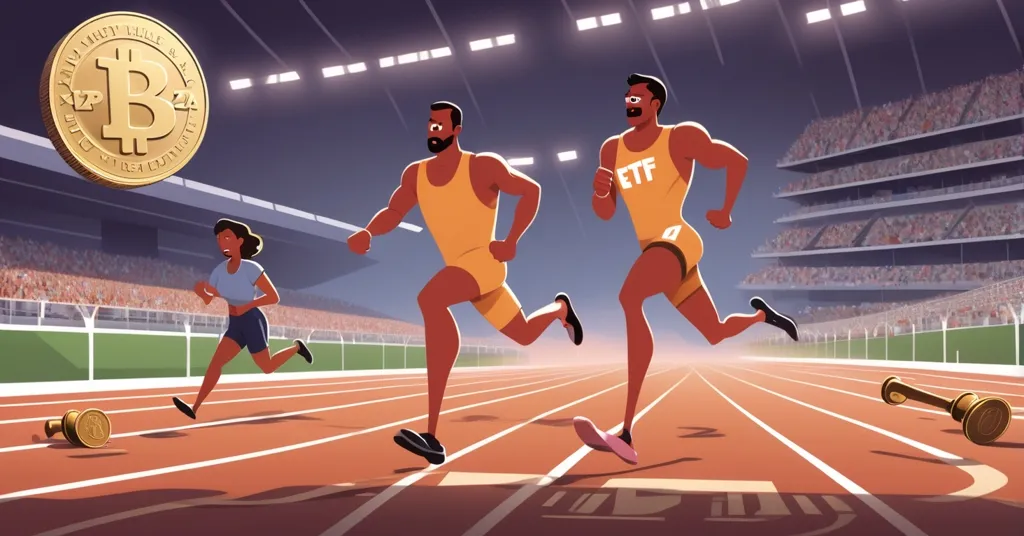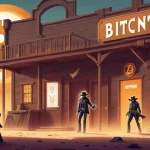XRP ETF Race Heats Up: July 2024 Deadlines Could Reshape Altcoin Investments

XRP ETF Race 2024: July Deadlines Could Redefine Altcoin Investment
July 2024 is shaping up to be a make-or-break moment for XRP, the polarizing altcoin tied to Ripple Labs. With a series of regulatory deadlines on the horizon, the push for XRP Exchange-Traded Funds (ETFs) in the US could either catapult this cryptocurrency into mainstream finance or leave it battered under the SEC’s unrelenting boot. Buckle up—this is high-stakes drama for altcoin enthusiasts and skeptics alike.
- Critical Dates: July 14, 21, and 25 are pivotal for XRP futures and spot ETF launches or decisions.
- Futures vs. Spot: Futures ETFs dodge heavier scrutiny, while spot ETFs grapple with XRP’s murky legal status.
- Key Players: ProShares, Volatility Shares, Tuttle Capital, and REX-Osprey lead, with others poised to follow.
Why July Matters for XRP ETFs
XRP has never been a darling of the crypto purists—its centralized roots with Ripple Labs holding a hefty chunk of the supply and its cozy ties to banking systems rub Bitcoin maximalists the wrong way. Yet, its promise in cross-border payments via RippleNet, positioning itself as a faster, cheaper alternative to clunky systems like SWIFT, keeps institutional interest alive. Since 2020, though, a dark cloud has hung over it: a lawsuit from the Securities and Exchange Commission (SEC) questioning whether XRP is a security. If it is, it’s bound by the same rigid rules as stocks, stifling its freewheeling crypto appeal. This legal limbo has kept XRP on the fringes of traditional financial products—until now. July’s deadlines could force a reckoning, and the outcomes might not just shape XRP but signal how far regulators will let altcoins infiltrate Wall Street. For more on this critical timeline, check out the latest on the XRP ETF race heating up.
July 14: ProShares Fires the First Shot with Futures ETFs
Kicking off the month, ProShares is eyeing July 14 to launch three XRP futures ETFs: the Ultra XRP ETF, UltraShort XRP ETF, and Short XRP ETF. These products let investors bet on XRP’s price movements—both up and down—without holding the actual coin. Futures ETFs are a bit of a workaround; they track price contracts rather than the spot price, meaning you’re essentially gambling on future value instead of owning the asset. This setup has historically been an easier sell to the SEC, who seem to grumble less about derivatives than direct crypto exposure. If the SEC doesn’t raise objections by this date, ProShares could notch an early victory for leveraged crypto plays in traditional markets. You can review the official filings for these products on the SEC’s updates for XRP ETF filings.
But don’t get too excited. Futures ETFs come with nasty hidden traps like “contango bleed.” That’s a fancy way of saying you lose money over time due to the cost of rolling over contracts when future prices are pricier than current ones—it’s like paying a recurring toll just to keep your investment alive. For Bitcoin futures ETFs like ProShares’ BITO, experts have pegged annual underperformance at anywhere from 2.5% to a brutal 8.4%. XRP’s market, less mature and more retail-driven with fewer arbitrage opportunities to close price gaps, could fare even worse. Add in the wild volatility of crypto, and these products start looking like financial dynamite—thrilling until they blow up in your face. For deeper insight into these risks, see this analysis on futures ETFs and their challenges.
July 21: Volatility Shares and Tuttle Capital Double Down
Fast forward to July 21, and the stakes get higher with Volatility Shares and Tuttle Capital stepping into the ring. Volatility Shares is pushing a 2X XRP ETF for amplified gains (and losses) alongside a standard XRP ETF, while Tuttle Capital aims for a 2X Long XRP Daily Target ETF. The SEC has already acknowledged these filings, a small nod that signals they’re at least on the radar. These leveraged ETFs are a different beast, designed to magnify daily price swings. A 10% jump in XRP could mean a 20% gain—or a 20% loss if it tanks. They’re a gambler’s delight, but for retail investors who don’t grasp the mechanics, they’re a fast track to wiped-out accounts. Community discussions around these key dates are buzzing, as seen in this Reddit thread on XRP ETF deadlines.
Let’s not sugarcoat it: leveraged products in crypto’s rollercoaster market are a recipe for disaster if you’re not vigilant. Beyond contango risks, there’s also the threat of intra-day volatility and counterparty issues—basically, if the other side of your bet doesn’t pay up, you’re screwed. The SEC filing risks for similar products highlight these pitfalls, and XRP’s thinner liquidity compared to Bitcoin could amplify them. If you’re diving in, read the fine print twice. We’re not your nanny, but we’ve seen too many get burned by shiny promises of quick gains. For a breakdown of specific investment risks, take a look at this piece on XRP futures versus spot ETF risks.
July 25: REX-Osprey Spot ETF—the Holy Grail or a Pipe Dream?
The real showdown hits on July 25, when the SEC is slated to decide on the REX-Osprey Spot XRP ETF. Unlike futures, spot ETFs track the actual price of XRP, offering a purer investment play—think of it as owning a slice of the real thing versus betting on a shadow. That direct exposure makes them the gold standard for investors but a regulatory nightmare for the SEC. The agency’s long-standing hesitation on spot crypto ETFs, rooted in fears of market manipulation and investor protection, is dialed up to eleven for XRP due to its unresolved security status. A green light here could mark one of the first spot XRP ETFs in the US, a historic win that might finally legitimize the coin in traditional finance. For background on XRP’s framework, refer to the XRP Ledger overview.
Other big names like Bitwise, 21Shares, and CoinShares are watching with bated breath, their own spot XRP ETF filings ready to ride the wave of a favorable ruling. After Bitcoin spot ETFs broke through in 2024 following over a decade of rejections, there’s a sliver of hope the SEC might soften its stance. But XRP isn’t Bitcoin. Its legal baggage and Ripple’s centralized grip on the supply—over 40 billion tokens in escrow—fuel the SEC’s paranoia about manipulation. If it’s a rejection, it’s another gut punch, cementing altcoins as too wild for Wall Street’s sanitized portfolios. Either way, this decision will send shockwaves through the crypto space.
XRP’s Legal Quagmire: The Elephant in the Room
Let’s dig into why the SEC’s so hell-bent on keeping XRP at arm’s length. The lawsuit, dragging on since 2020, hinges on whether XRP is a security. A partial ruling in 2023 said XRP isn’t always a security when sold on exchanges, but sales to institutional investors might be—a half-win that’s left everyone confused. If classified fully as a security, XRP would face suffocating regulations, making ETFs a non-starter. This ambiguity sets XRP apart from Bitcoin, whose decentralized nature and market maturity finally forced the SEC’s hand on spot ETFs. Even Ethereum, with its own regulatory gray areas, seems closer to spot ETF approval than XRP. Until this legal mess clears, every spot ETF filing is a coin toss with a weighted tail. For perspectives on this ongoing battle, see this discussion on the SEC lawsuit’s impact on XRP ETFs.
Compare that to Bitcoin’s journey: over ten years of SEC stonewalling before spot ETFs got the nod in 2024. XRP’s timeline could be shorter if Ripple wins decisively, but its centralized design invites more scrutiny. Ripple’s Brad Garlinghouse has repeatedly slammed the SEC for being out of touch with innovation, but critics—including Bitcoin diehards like myself—argue XRP’s pre-mined supply and banker-friendly ethos betray crypto’s rebellious core. It’s a philosophical clash as much as a legal one, and the SEC’s infuriating, innovation-killing foot-dragging isn’t helping. For recent developments on this front, watch this Bloomberg segment on XRP’s legal challenges.
The Bigger Picture: Altcoins, Regulation, and Decentralization
Zooming out, the XRP ETF race isn’t just about one coin; it’s a litmus test for altcoins in traditional finance. As someone who leans Bitcoin maximalist, I’ll grumble that XRP’s centralized setup undermines the ethos of decentralization we champion. Bitcoin is sound money, a middle finger to centralized control; XRP often feels like a banker’s pet project. Yet, I can’t deny it fills a niche—cross-border payments—where Bitcoin’s slower, pricier transactions don’t compete. If spot ETFs get approved, especially REX-Osprey’s on July 25, it could unleash fresh capital and onboard millions to crypto, flawed as XRP may be. That’s effective accelerationism in action: pushing adoption even if the vehicle isn’t perfect.
But here’s the devil’s advocate bit—does XRP’s success come at the cost of bowing to centralized oversight? ETF approvals mean more regulatory strings, potentially taming crypto’s wild spirit. And let’s not ignore the elephant: Ripple’s massive holdings make market manipulation a real fear, more so than Bitcoin’s dispersed ownership. A spot ETF rejection might sting, but it could also protect the space from premature overreach. Compare this to Ethereum, where staking and DeFi use cases complicate ETF filings but lack XRP’s specific legal thorns. Every decision this month ripples beyond XRP, shaping whether altcoins are seen as legit assets or regulatory hot potatoes.
Scam Alert: Don’t Fall for the Hype
A quick heads-up—high-profile events like these ETF deadlines are catnip for scammers. Fake announcements, phishing schemes, and pump-and-dump shills often spike around such news. If someone’s promising guaranteed XRP moonshots or claiming insider ETF approval leaks, run the other way. We’ve got zero tolerance for fraudsters here, and you shouldn’t either. Stick to verified sources, and don’t let greed cloud your judgment. Crypto’s already risky enough without handing your wallet to a con artist.
What to Watch Next
As July unfolds, every SEC whisper will have the crypto crowd—newcomers and battle-hardened OGs—on edge. Will XRP crash through the ETF gates, or face another brutal smackdown? Beyond the immediate outcomes, keep an eye on how these decisions influence broader altcoin ETF filings and the SEC’s evolving stance on crypto. This saga is a raw, messy snapshot of a financial revolution in progress. Stay sharp, do your homework, and don’t buy into empty promises—real change doesn’t come without a fight.
Key Questions and Takeaways on XRP ETFs
- What are the key July 2024 dates for XRP ETF progress?
July 14 for ProShares’ futures ETFs, July 21 for Volatility Shares and Tuttle Capital’s leveraged and standard ETFs, and July 25 for the SEC’s ruling on the REX-Osprey spot XRP ETF. - Why are futures XRP ETFs more likely to succeed than spot ETFs?
Futures ETFs, based on price contracts, face less regulatory pushback as they avoid direct asset ownership, while spot ETFs are stalled by the SEC’s concerns over XRP’s unresolved security status. - What risks do XRP futures ETFs pose to investors?
Risks include contango bleed, with potential annual underperformance of 2.5% to 8.4% based on Bitcoin futures data, plus amplified losses in leveraged products due to crypto’s volatility and liquidity gaps. - Could a spot XRP ETF approval reshape altcoin markets?
Yes, a REX-Osprey approval on July 25 could legitimize XRP in traditional finance, setting a precedent for other altcoin ETFs and drawing significant institutional capital to the space. - How does XRP’s SEC lawsuit impact ETF prospects?
The ongoing debate over XRP as a security creates uncertainty, fueling SEC reluctance on spot ETFs and casting doubt on XRP’s broader integration into regulated financial products.



